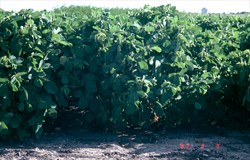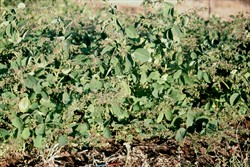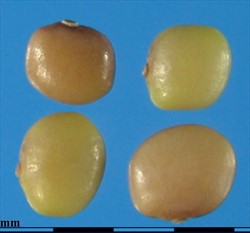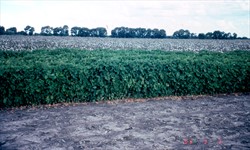Bouffordia dichotoma
Tropical Forages
Bouffordia dichotoma (Willd.) H. Ohashi & K. Ohashi
Basionym: Hedysarum dichotomum Willd.; Desmodium dichotomum (Willd.) DC.; Desmodium diffusum (Willd.) DC.; Hedysarum diffusum Willd.
Family: Fabaceae (alt. Leguminosae) subfamily: Faboideae tribe: Desmodieae.
Herbaceous to suffrutescent, procumbent to nearly erect (20‒80 cm tall), annual or perennial. Stems to 1 m long, branched, 4‒5 angled, grooved, moderately to densely hispidly pubescent with long tapering or spreading hooked hairs. Leaves trifoliolate (sometimes unifoliolate near base of stem) with obliquely ovate-acuminate stipules, 5‒15 mm long, 3‒9 mm wide with lobes almost overlapping; petiole 1‒7 cm long, hairy; rachis 0.8‒3 cm long; petiolules 2‒3 mm long; leaflets ovate to elliptic (sometimes orbicular), obtuse at the base and apex, or base cuneate and apex retuse; appressed pilose above and velutinous on the under surface, with long stout tapering hairs along the midrib and chief lateral veins, more delicate hairs of varying lengths abundant over whole surface, venation raised beneath; terminal leaflet 1.8‒10 cm long and 2‒7 cm wide, lateral leaflets 1.2‒7 cm long and 1.0‒4.8 cm wide, stipels very distinct, 5‒9 × 1‒2.5 mm, lanceolate. Inflorescence axillary or terminal, racemose or racemose-paniculate 5‒45 cm long, with densely uncinulate-pubescent rachides, laxly flowered, 2- or 3-flowered at each node. Flowers small, pink or blue, standard 3.3‒3.5 mm long, 2.5‒3 mm wide, pedicel 2-5 mm long. Fruit 7‒18 mm long, sessile to shortly stipitate (stipe 0.5–1.5 mm long), (2‒) 4‒6 (‒ 8) articled; articles quadrate at maturity, shallowly and nearly evenly indented along both sutures, 2‒3 mm long and 2.5‒3 mm wide. Seed yellow or chestnut brown, oval-reniform, 2 mm long and 1.5 mm wide.
China: 二歧山蚂蝗 er qi shan ma huang; 单序山蚂蝗
English: dichotomous-stemmed desmodium, tick-trefoil desmodium (generic for Desmodium)
Ethiopia: chimero
India: चिकटा chikta (Marathi); asud; gander-lapto
Native:
Africa: Cameroon; Chad; Ethiopia; Sudan; Uganda
Asia: China (Yunnan); India; Indonesia (Celebes, Java); Myanmar
Forage
B. dichotoma has shown potential as a forage crop on heavy clay soils in sub-humid, seasonally dry tropical and subtropical environments.
Environment
It has shown potential as a green manure and as an annual ley legume.
Other
Considered to have medicinal properties for treating epizootic lymphangitis (Aari language: tushita) in equines, and stomach ache and fever in humans.
Soil requirements
Most of the lines collected originate from slightly acid to alkaline soils, the most acid being pH 5.5. The only accession of this species that has been used in experiments originated from the Sudan and is well adapted to heavy textured alkaline soils.
Moisture
It is well adapted to dry and semi-arid environments on clay soils where it has the capacity to efficiently extract moisture.
Temperature
B. dichotoma is a widely distributed species, originating from around 23° N in Yunnan, China, 12° N in Africa, and 20° N in India to 13° S in Africa and 10° S in Indonesia, and from near sea level to 1700 m asl. This equates to an average annual temperature range from about 22 to 29 °C. In evaluation experiments it has been productive in regions throughout the tropics of northern Queensland and the southern Queensland and northern New South Wales cropping systems which are environments with hot summers, with maximum temperatures frequently in excess of 35 ºC. It is not frost tolerant and the Sudanese accession was burnt by frosts.
Light
Various websites report that this species comes from forests and thickets, as well as grassland, suggesting it has some shade tolerance.
Reproductive development
Flowering data vary with the flora report: India, September‒February; China, June‒August.
Defoliation
B. dichotoma is extremely palatable and will always be preferentially grazed. Its high palatability can result in it being grazed to ground level so a large degree of grazing management is important if a seed crop is desired.
Fire
No information available.
Guidelines for establishment and management of sown forages.
Establishment
B. dichotoma establishes readily in well prepared seedbeds. It has a relatively small seed so the recommended depth of sowing is about 1 cm and should not exceed 2 cm. The clay soils in which it might be used often have soil crusting characteristics which can reduce establishment significantly if seed is sown too deep and seed is of poor quality (low vigour). B. dichotoma can have a large percentage of hard seed and this should be tested. If hard seed is greater than 50%, then seed should be scarified before sowing. The rhizobium requirements for B. dichotoma have not been evaluated but it could be expected that the standard strain for Desmodium (CB 627 in Australia) should be used. Recommended planting rate when sown for a pure stand is 2 kg/ha.
Fertilizer
As in most legumes, B. dichotoma would be expected to respond to applications of P and Mo, and S may also be necessary in some situations.
Compatibility (with other species)
Most potential for B. dichotoma is as an annual ley legume or a forage crop. Little is know of its compatibility but it should be compatible with most grass species in their first year of establishment.
Companion species
Grasses: Can be intercropped with Cenchrus americanus, Sorghum spp. and Zea mays in open rows.
Legumes: No published information. Grows in similar environment to Desmanthus spp., Lablab purpureus and Vigna unguiculata.
Pests and diseases
No pests and diseases have been observed in its early trials.
Ability to spread
It should have low ability to spread due to its very high palatability.
Weed potential
Unlikely to have weed potential because of its palatability .
Nutritive value
Levels of 15% ash, 22% CP, 31% NDF, 26% ADF, 5.8% ADL, 61% IVDMD, 0.6% Ca, 0.2% P, 0.15% K, 0.8% Mg, 0.01% Na, 0.3% S, 4 ppm Cu, 1,600 ppm Fe, 45 ppm Mn and 12 ppm Zn.
Palatability/acceptability
Extremely palatable and selectively grazed by cattle; may be less palatable to small ruminants, equines and camels.
Toxicity
None reported.
Dry matter
Dry matter yields in southern Queensland have ranged from 2 to 6 t/ha/year when grown under rainfed conditions of about 750 mm/yr on deep clay soils in a subtropical environment. DM yields ranged from 4.1 to 4.8 t/ha from a single harvest in the elevated tropics of the Amhara region of Ethiopia with 680‒1,200 mm mean annual rainfall.
Animal production
No information available.
Self-pollinated; 2n = 22.
Large scale seed production has not been attempted but seed is held on the plant for some time after maturity which is conducive to both hand and mechanised harvesting.
No information available.
- Adapted to alkaline clay soils.
- High quality and potential as a ley legume and annual legume crop.
- Extremely palatable.
- Non bloating.
- Small seed may result in establishment difficulties on clay soils.
- Palatability will necessitate significant attention to grazing management.
Abebe, H. (2020) A survey to assess the value of the legume chimero (Bouffordia dichotoma syn. Desmodium dichotomum) in mixed farming systems in North and South Wollo Zones, Amhara Region, Ethiopia. Tropical Grasslands-Forrajes Tropicales 8:11–19. doi.org/10.17138/tgft(8)11-19
Clem, R.L. and Hall, T.J. (1994) Persistence and productivity of tropical pasture legumes on three cracking soils (Vertisols) in north-eastern Queensland. Australian Journal of Experimental Agriculture 34:161–171. doi.org/10.1071/EA9940161
None released to date.
CPI 47186 Selected in Australia. Origin Abu-Naama, Sudan (12°43' N, 450 m asl, rainfall 400 mm) A semi-erect annual, evaluated as a ley species in cropping systems.








